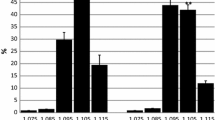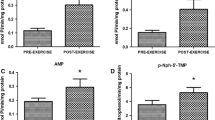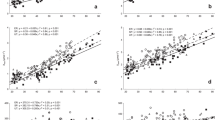Abstract
During prolonged maximal exercise, oxygen deficits occur in working muscles. Progressive hypoxia results in the impairment of the oxidative resynthesis of ATP and increased degradation of purine nucleotides. Moreover, ATP consumption decreases the conversion of UDP to UTP, to use ATP as a phosphate donor, resulting in an increased concentration of UDP, which enhances pyrimidine degradation. Because the metabolism of pyrimidine nucleotides is related to the metabolism of purines, in particular with the cellular concentration of ATP, we decided to investigate the impact of a standardized exercise with increasing intensity on the concentration of uridine, inosine, hypoxanthine, and uric acid. Twenty-two healthy male subjects volunteered to participate in this study. Blood concentrations of metabolites were determined at rest, immediately after exercise, and after 30 min of recovery using high-performance liquid chromatography. We also studied the relationship between the levels of uridine and indicators of myogenic purine degradation. The results showed that exercise with increasing intensity leads to increased concentrations of inosine, hypoxanthine, uric acid, and uridine. We found positive correlations between blood uridine levels and indicators of myogenic purine degradation (hypoxanthine), suggesting that the blood uridine level is related to purine metabolism in skeletal muscles.


Similar content being viewed by others
References
Astrand PO, Rodhal K (1986) Textbook of work physiology: physiological bases of exercise. McGraw-Hill, New York
Bangsbo J, Sjödin B, Hellsten-Westing Y (1992) Exchange of hypoxanthine in muscle during intense exercise in man. Acta Physiol Scand 146:528–533
Cansev M (2006) Uridine and cytidine in the brain: their transport and utilization. Brain Res Rev 52:389–397
Hamada T, Mizuta E, Yanagihara K, Kaestu Y, Sugihara S, Sonoyama K, Yamamoto Y, Kato M, Igawa O, Shigemasa Ch, Inokuchi T, Yamamoto T, Shimada T, Ohtahara A, Ninomiya H, Hisatome I (2007) Plasma levels of uridine correlate with blood pressure and indicators of myogenic purine degradation and insulin resistance in hypertensive patients. Circ J 71:354–356
Hellsten Y, Sjödin B, Richter A, Bangsbo J (1998) Urate uptake and lowered ATP levels in human muscle after high-intensity intermittent exercise. Am J Physiol Endocrinol Metab 274:600–606
Hellsten Y, Richter EA, Kiens B, Bangsbo J (1999) AMP deamination and purine exchange in human skeletal muscle during and after intense exercise. J Physiol 520:909–920
Hellsten-Westing Y, Ekblom B, Sjödin B (1989) The metabolic relation between hypoxanthine and uric acid in man following maximal short-distance running. Acta Physiol Scand 137:341–345
Hellsten-Westing Y, Balsom PD, Norman B, Sjödin B (1993) Changes in plasma hypoxanthine and free radical markers during exercise in man. Acta Physiol Scand 149:405–412
Hellsten-Westing Y, Norman B, Balsom PD, Sjödin B (1993) Decreased resting levels of adenine nucleotides in human skeletal muscle after high intensity training. J Appl Physiol 74:2523–2528
Hellsten-Westing Y, Ekblom B, Kajser I, Sjödin B (1994) Exchange of purines in human liver and skeletal muscle with short-term exhaustive exercise. Am J Physiol 266:81–86
Nyhan WL (2005) Disorders of purine and pyrimidine metabolism. Mol Genet Metab 86:25–33
Ohno M, Ka T, Inokuchi T, Moriwaki Y, Yamamoto A, Takahashi S, Tsutsumi Z, Tsuzita J, Yamamoto T, Nishiguchi S (2008) Effects of exercise and grape juice ingestion in combination on plasma concentrations of purine bases and uridine. Clin Chim Acta 388:167–172
Page T, Yu A, Fontanesi J, Nyhan WL (1997) Developmental disorder associated with increased cellular nucleotidase activity. Proc Natl Acad Sci USA 94(21):11601–11606
Sahlin K, Ekberg K, Cizinsky S (1991) Changes in plasma hypoxanthine and free radical markers during exercise in man. Acta Physiol Scand 142:275–281
Sahlin K, Tonkonogi M, Söderlund K (1999) Plasma hypoxanthine and ammonia in humans during prolonged exercise. Eur J Appl Physiol 80:417–422
Smolenski RT, Lachno DR, Ledingham SJM, Yacoub MH (1990) Determination of sixteen nucleotides, nucleosides and bases using high-performance liquid chromatography and its application to the study of purine metabolism in heart for transplantation. J Chromatogr 527:414–420
Smolenski RT, Lachno DR, Yacoub MH (1992) Adenine nucleotide catabolism in human myocardium during heart and heart–lung transplantation. Eur J Cardiothorac Surg 6:25–30
Smoleński RT, de Jong JW, Janssen M, Lachno DR, Zydowo MM, Tavenier M, Huizer T, Yacoub MH (1993) Formation and breakdown of uridine in ischemic hearts of rats and humans. J Mol Cell Cardiol 25:67–74
Stathis CG, Febbraio MA, Carey MF, Snow RJ (1994) Influence of sprint training on human skeletal muscle purine nucleotide metabolism. J Appl Physiol 76:1802–1809
Stathis CG, Zhao S, Carey MF, Snow RJ (1999) Purine loss after repeated sprint bouts in humans. J Appl Physiol 87:2037–2042
Sutton JR, Toews CJ, Ward R (1980) Purine metabolism during strenuous exercise in man. Metabolism 29:254–260
Traut TW, Jones ME (1996) Uracil metabolism—UMP synthesis from orotic acid or uridine and conversion of uracil to β-alanine: enzymes and cDNAs. Prog Nucleic Acid Res Mol Biol 53:1–78
Wice BM, Kennell D (1982) Ribose-1-P is the essential precursor for nucleic acid synthesisin animal cells growing on uridine in the absence of sugar. J Biol Chem 257(5):2578–2583
Yamamoto T, Moriwaki Y, Takahashi S, Tsutsumi Z, Yamakita J, Higashino K (1997) Effect of muscular exercise on the concentration of uridine and purine bases in plasma—adenosine triphosphate consumption-induced pyrimidine degradation. Metabolism 46:1339–1342
Yamamoto T, Moriwaki Y, Takahashi S, Tsutsumi Z, Yamakita J, Higashino K (1997) Is the plasma uridine level a marker of the overproduction of uric acid. Metabolism 46:801–804
Yamamoto T, Moriwaki Y, Takahashi S, Yamakita J, Tsutsumi Z, Ohata H, Hiroishi K, Nakano T, Higashino K (1997) Effect of ethanol and fructose on plasma uridine and purine bases. Metabolism 46:544–547
Yamamoto T, Moriwaki Y, Takahashi S, Yamakita J, Nakano T, Hiroishi K, Higashino K (1998) Xylitol-induced increase in the plasma concentration and urinary excretion of uridine and purine bases. Metabolism 47:739–743
Yilmaz MS, Coskun C, Suzer O, Yalcin M, Mutlu D, Savci V (2008) Hypotensive effects of intravenously administered uridine and cytidine in conscious rats: involvement of adenosine receptors. Eur J Pharmacol 584:125–136
Zhao S, Snow RJ, Stathis G, Febbraio MA, Carey MF (2000) Muscle adenine nucleotide metabolism during and recovery from maximal exercise in humans. J Appl Physiol 88:1513–1519
Acknowledgments
The study was supported by grant no. N404 281337 from the State Committee for Scientific Research.
Author information
Authors and Affiliations
Corresponding author
Rights and permissions
About this article
Cite this article
Dudzinska, W., Lubkowska, A., Dolegowska, B. et al. Blood uridine concentration may be an indicator of the degradation of pyrimidine nucleotides during physical exercise with increasing intensity. J Physiol Biochem 66, 189–196 (2010). https://doi.org/10.1007/s13105-010-0023-9
Received:
Accepted:
Published:
Issue Date:
DOI: https://doi.org/10.1007/s13105-010-0023-9




